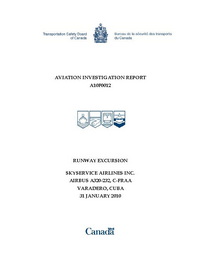
This information is added by users of ASN. Neither ASN nor the Flight Safety Foundation are responsible for the completeness or correctness of this information.
If you feel this information is incomplete or incorrect, you can submit corrected information.
| Date: | Sunday 31 January 2010 |
| Time: | 21:49 |
| Type: |  Airbus A320-232 |
| Owner/operator: | Skyservice Airlines |
| Registration: | C-FRAA |
| MSN: | 1411 |
| Year of manufacture: | 1999 |
| Engine model: | IAE V2527-A5 |
| Fatalities: | Fatalities: 0 / Occupants: 186 |
| Other fatalities: | 0 |
| Aircraft damage: | Minor, repaired |
| Category: | Serious incident |
| Location: | Varadero-Juan Gualberto Gomez Airport (VRA/MUVR) -
 Cuba Cuba
|
| Phase: | Landing |
| Nature: | Passenger |
| Departure airport: | Toronto-Pearson International Airport, ON (YYZ/CYYZ) |
| Varadero-Juan Gualberto Gomez Airport (VRA/MUVR) | |
| Investigating agency: | TSB |
| Confidence Rating: |
The Skyservice Airlines Airbus A320-232 departed from Lester B. Pearson International Airport in Toronto, Ontario, for Juan Gualberto Gomez International Airport in Varadero, Cuba. At 21:49 Eastern Standard Time, shortly after touching down in heavy rain during the hours of darkness, the aircraft drifted off the runway to the right. After travelling approximately 1745 feet parallel to the runway, the crew was able to bring the aircraft back onto the runway. There were no injuries to the 179 passengers and 7 crew members. There was no fire and no evacuation was necessary. The aircraft sustained minor damage.
Findings as to Causes and Contributing Factors
1. As the aircraft neared the threshold, the precipitation rate increased and the crew lost their visual cues preventing them from detecting and correcting the aircraft's right drift prior to touchdown.
2. When the aircraft transitioned into the flare, the captain committed to the landing and believed a safe go around option no longer existed.
3. As the aircraft touched down in an established right turn, the combination of momentum, low tire cornering forces due to the contaminated runway and some form of hydroplaning, caused the aircraft to drift until it left the runway.
4. A combination of wet ground, reverse thrust, slope and wind resulted in the captain being unable to manoeuvre the aircraft back on the runway until the speed was reduced enough to allow for better tire traction.
5. The company’s lack of emphasis on the capabilities, operation and the re-activation of the rain repellent system likely contributed to the crew not using the system. The rain repellent system could have improved the forward visibility in the heavy precipitation.
Accident investigation:
 |
|
Sources:
TSB
Revision history:
| Date/time | Contributor | Updates |
|---|---|---|
| 22-May-2024 10:43 | Anon. | Updated [Cn] |
| 22-May-2024 10:46 | ASN | Updated [Total fatalities, Total occupants, Phase, Nature, Departure airport, Destination airport, Source, Damage, Narrative] |
| 22-May-2024 10:47 | ASN | Updated [Time, Location] |
Corrections or additions? ... Edit this accident description
The Aviation Safety Network is an exclusive service provided by:


 ©2024 Flight Safety Foundation
©2024 Flight Safety Foundation